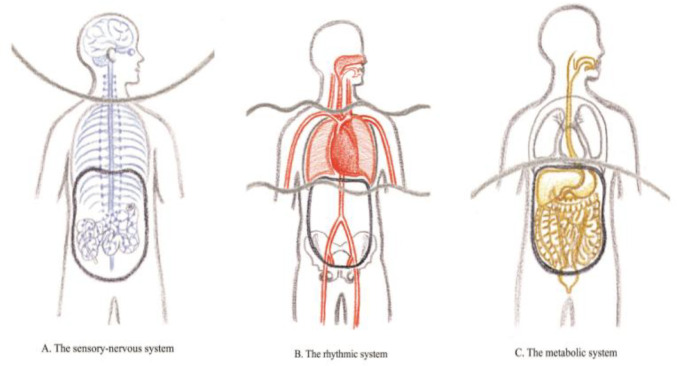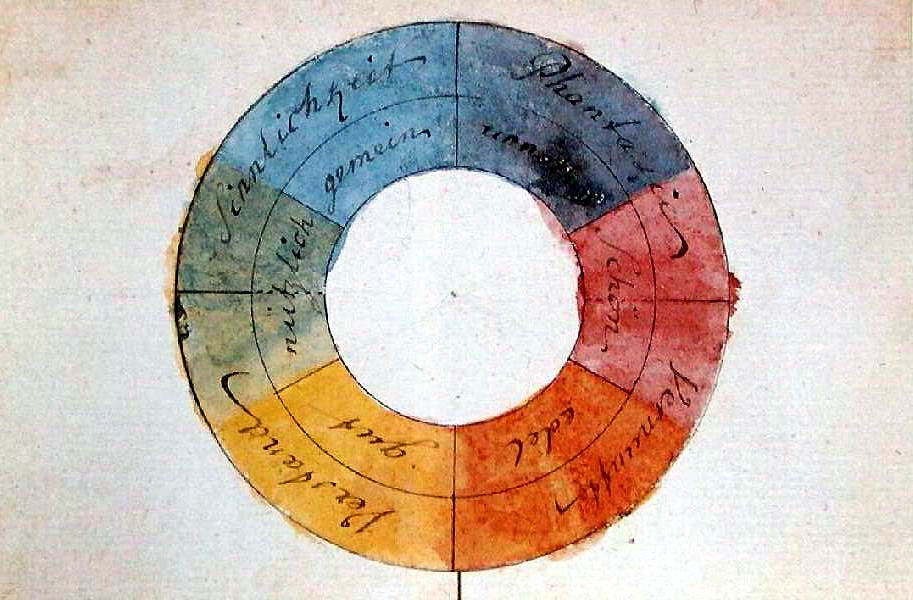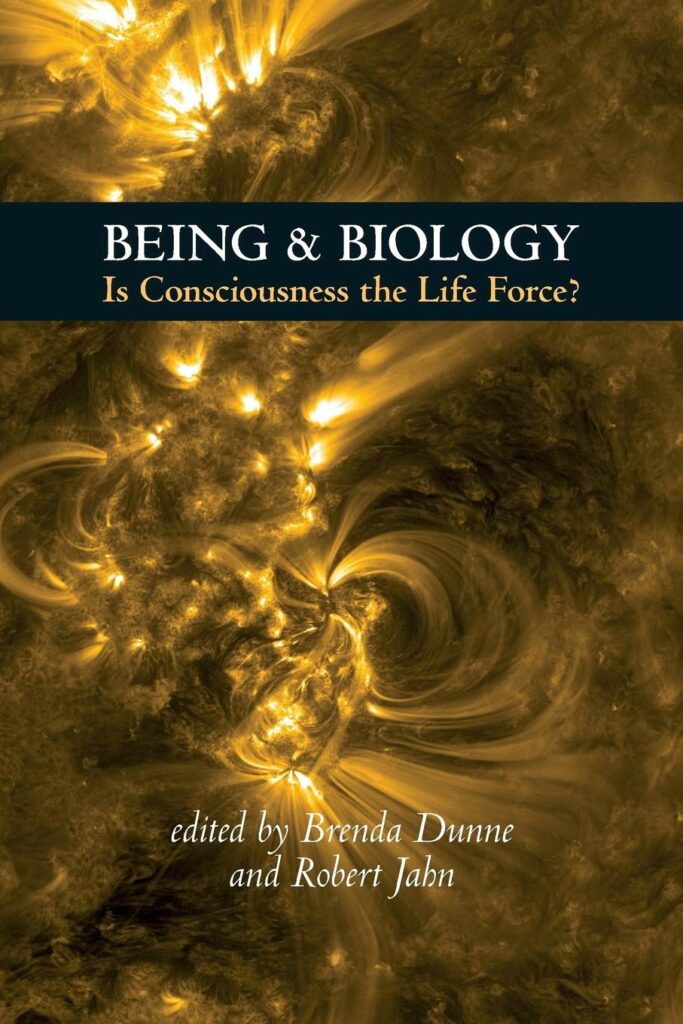
Complementing reductionism: Goethean science. Part 2
Part 2: Life’s unique principles
By AliciaLandman-Reiner
Abstract
Life sciences today approach nature through a reductionist lens. A broadened methodology, known as Goethean science, complements that one-sided perspective. Building on the elements of the qualitative and the wholeness of organisms, novel examples of non-reductionist work in plant growth, animal, and specifically human organization, are described.
Keywords
- Goethean science
- Plant morphology
- Mammalian morphology
- Threefold
- Mind-body
- Anthroposophic medicine
Introduction
This paper is the second in a two-part series introducing modern Goethean science, a non-reductionist approach to studying nature, which complements mainstream science.
In the first paper, the history of Goethean science is briefly surveyed, from the renowned German author Johann Wolfgang von Goethe’s prolific scientific production, to its lapse into obscurity, its re-discovery and explication by Rudolf Steiner, to the contemporary research inspired and informed by that earlier work. The first paper describes how scientists, observing without reductionist preconceptions, arrive at a qualitative understanding of an animal or plant species. It examines the problem of apprehending the holism, or “wholeness” of organisms, a characteristic that is resistant to purely reductionist research and theory.1
This second paper shows how Goethean principles lead to new ways of grasping life’s organizational complexity that complement, not refute, mainstream reductionist approaches. Growth patterns in annual plants are considered. Next, a threefold principle of body-mind organization is described, holistic and qualitative, and positing a continuum of consciousness in the body. The breadth of its applications to biology and integrative medicine is indicated.
Goethean natural science: Life’s unique dynamics
Nowhere do we find repose or completion… If we wish to achieve a living perception of nature, we must strive to keep ourselves as mobile and flexible as the examples she herself provides. Johann Wolfgang von Goethe.2
Throw a ball. Its trajectory in space and time follow the well-defined laws of physics. Imagine a mountain, pushed up by forces of heat deep in the earth, and worn down by wind and water over eons: the same set of laws are at work as in the ball’s motion, only more to compute. But to watch a dandelion’s green leaf rosette appear in the lawn, send up a shoot, open into a yellow flower head made up of dozens of minute florets, and fade to a pale seed-head on a stalk which withers and disappears, is to witness changes in space and over time which speak of an altogether different level of complexity and organization. Anyone who has been awestruck by the growth of an embryo, may consider that an ordinary plant goes through such precisely orchestrated transformations, year in and year out. Unifying principles of physics allow our thinking to penetrate the motion of inanimate objects. Goethe (1749–1832), German author and scientist, proposed unifying principles for dynamism in organic nature.
Goethe was already an acclaimed novelist and playwright in his twenties, when he began studying plants in his own large garden. Ten years later, on a two-year journey from Germany to southern Italy and back, he observed plant life in different environments.3 What drew his attention was growth and change: metamorphosis.4 His-method was to look, not for forces working unseen behind the phenomena, e.g. of chemistry; but for patterns – the explanatory script – in plants’ visibly changing forms. He discovered two principles, “the two great driving forces in all nature” polarity and enhancement.5
Using the annual plant as his model, Goethe described the dynamics of plant growth as a series of alternating polar gestures of contraction and expansion. Each typical annual goes through three contraction-expansions as it grows: from the contracted seed, expanding into leaves; again contracting into sepals, then expanding into a flower; contracting for a third time into stamen and pistils, and finally expanding into the fruit. This is an orderly and complex metamorphosis.6 Furthermore, this metamorphosis can progress or retrogress: we can view a stamen as a contracted petal, or the reverse, a petal as an expanded stamen.7 Goethe’s “foliar theory” is still cited today as the origin of our current understanding that embryonic plant tissue, the meristem, can develop into a stem, leaf, petal, or other plant part – or backwards, a floral meristem reverting to leaf meristem. Furthermore, transitional structures can be found, catching development in the act. Plants can be tremendously flexible, expressing in their forms, ceaseless motion.
Goethe’s second principle is enhancement, meaning rising to a qualitatively higher level.8 We can find enhancement in a plant’s transformations, from the simplicity of green leaves to the emergence of a colorful, diversely-petaled and scented flower corolla; above and beyond this, the duality of stamen and pistils’ forms and their elaborate interactions with insects and birds; and finally the resulting fruit, containing in its seeds the whole plant’s potential in miniature. This is progression from something simpler to something altogether “more,” a qualitative enhancement, a richness, a ripe complexity.
Goethe and the current scientists whose work has been inspired by his ideas, advise that, to fully cognize a plant’s transformation processes, we should picture what we see in sequence: with precise imagination, moving forwards and backwards from one form to the next, like practicing scales in music, to gain proficiency with metamorphic perceiving and thinking. These scientists argue that to adequately grasp a plant’s growth we need to do something, in addition to what we do when we think only logically. It is a practice, whose “effort (is) to achieve direct experience of these transitional movements, or better, moving forms”.9
To some, for a scientist to visualize leaves and flowers might seem like a radical departure. In fact, it is not unusual in current science and medicine, to need to practice in order to perceive something real. Learning to see pathology in cells under the microscope, for example, takes considerable practice and experience – “See those inclusions in that cell?” “Not yet…” – and more experience and feedback to judge what one sees. If you ever accompany someone into the field, an expert in botany, birds or dinosaur tracks, at first one doesn’t even see what the expert is seeing. What variation in that wing? That indentation in the rock is a footprint of an ancient reptile? It can take knowing and practice, to really see.
It is reasonable then, that to interpret the footprints of life10, 11, 12 which can be seen in a sequence of leaves up the stem of an annual plant, or the transition from leaf to flower to fruit, we must practice. We thereby refine our cognitive technique, “releasing new powers of mind.”13 Studying its footprints, the living world seen macroscopically can become legible: its dynamic in time, utterly different from the world of inert matter, but following well-articulated principles, or laws.14
Such principles do not replace mainstream biology, such as the study of auxins, hormones which regulate thickness or length of a plant in relation to sun or soil; or the many genes involved in the shape-formation of leaves. But, while we now know vastly more about such mechanisms of plant growth regulation than we did 200 years ago in Goethe’s time, the problem of exactly how the complex sequences of leaf forms and flowers are achieved, is still very much a work in progress.15,16 Goethean-style plant study complements molecular biology; and it develops distinct cognitive skills in the investigator.
Goethe concluded his botanical work, “Metamorphosis of Plants,” with uncharacteristic reserve: “(I) will discuss this material in a more precise and detailed way…perhaps then it will be more deserving of applause than at present.”17 Applause was indeed restrained: few contemporaries grasped what he was getting at.18 But in the 20th and 21st centuries, those who have recognized the limitations of overweening physico-chemical reductionism in biology, have seen in his method “a wholly other way of thinking, …perfectly suited to apprehending the nature of life in all its manifestations… progressing from the space-gestalt to the time-gestalt.”19 These researchers have applied the Goethean dynamic-morphologic approach to botanical and animal form and growth.
Jochen Bockemuehl has described in great detail over many plant species, how markedly leaf forms change shape, as leaves successively emerge from bottom to top of the stem, a process called phyllotaxis. This change of shape progresses in four stages: stemming in which the petiole (leaf’s stem) is prominent; spreading or enlarging; segmenting or indenting; and sprouting (diminishing and pointing like a sprout). Bockemuehl shows that while leaf configurations vary greatly across plant species, these qualitative changes are lawful; Fig.1.20 In Fig. 1, lower series, seen left to right, in leaves 1–4 the stem lengthens, i.e. “stemming”; in leaves 5 and 6, additional projecting elements can be seen and the leaves enlarge, i.e. “spreading”; in leaves 6, 7 (tallest leaf), 8 and 9, “segmenting” can be seen in the more prominent projecting segmented elements, and slighter indentations in the leaf blades themselves; from leaves 9, 10 and 11, the petiole continues to reduce, segmented elements grow smaller and fewer; and leaves 10 through the last, 15th leaf, shrink in size and become lance-shaped, i.e. “pointing.” One stage is here not strictly completed before the next begins, the stages interweaving to some extent.

Fig. 1.. Leaf sequence from base of stem upwards (phyllo6taxis), two series showing progression of shape and size. (Bockemuehl 2010 p 40, courtesy Mercury Press.).
Bockemuehl furthermore describes shape progression within the leaf meristem, the embryonic plant tissue; Fig. 2.20,21 He found, remarkably, that development from meristem to full-grown leaf gives rise to forms in inverse order from the shape progression of individual leaves up the stem. In Fig. 2, from left to right (the upper line is magnified), a small pointed shape (“pointing”) becomes a larger and stemmed leaf, “segmenting,”, that enlarges considerably (“spreading”) and then “stemming” becomes prominent. Suchantke identifies this as an example of juvenilization, also referred to as neotony, the retention of youthful traits in maturity, a well-recognized principle of evolutionary developmental biology (evo-devo).22 Such dynamics were pointed to by Gould,23 recognized by Goethean scientists Schad, Rohen and others, and then “independently ‘rediscovered’” as heterochronic shifts, or differences in the timing of development.24 The dynamism typical of Goethean principles, appears relevant to understanding the complex organization of life in time.

Fig. 2.. Growth from meristem to leaf, left to right. Actual sizes are shown in line-drawings lower row. (Bockemuehl 2010 p 40, courtesy Mercury Press.).
Brazilian researchers have shown that Goethe’s principles can be applied to patterns in plant growth.15 The primacy of the leaf is consistent with the current “ABC” model of the genetics of floral development.25 In Aradopsis sp., the sepals, the outermost floral structures, are determined by one set of genes, “A-function,” operating alone; the next inner structures, the petals, require both A and B-function genes. The stamens, still further inward, require B and C-function genes, and lastly the carpels and ovules require C, D and E-functions. When a plant is produced with all ABC functions depleted, the resulting organ is a foliage leaf. That is, the leaf is the default structure.15
A second Goethean principle, enhancement, is seen in the regulation of the development of floral structures. Thirdly, they describe “cycles of expansion and contraction” of gene expression within the meristem, where succeeding forms arise over the plant’s life cycle.
Dynamics exemplified in the growing plant are rife in the organic world. The authors summarize, “Put Goethe’s three formative principles together…and the vast botanical diversity of our planet falls under the chief vision of formalism: production of a final form from interaction of a few abstract, general, and internally based (not externally imposed and adaptationally driven) morphological laws.” They conclude that Goethean principles may contribute to “the elaboration of a theoretical frame,” i.e. provide formal context for advances in evolutionary and developmental plant biology.15
Goethean natural science: Steiner’s threefold organizing idea
By far the most significant event…– opening up totally new dimensions far beyond Goethe – was the discovery, by Rudolf Steiner, of the threefold physiological and morphological structure of the human organism. Andreas Suchantke.26
A far-reaching example of Goethean science is Rudolf Steiner’s threefold idea.A Steiner (1861–1925) was trained in mathematics and science, earning a PhD in philosophy from Rostock University, Germany. At 21 he was assigned to edit Goethe’s scientific writing; a few years later, appointed science editor for a national complete works of Goethe, and authored two books on Goethe’s science and philosophy.27, 28, 29,A
By his own account, Steiner had arrived at his threefold principle empirically, confirming and refining it through decades of study.30 His–threefold organizing idea31 for human body and mind illuminates the inner logic of human form and physiology.32 Applications of his threefold principle are fundamental to Anthroposophic Medicine, an integrative medical approach,33 and shape the child-developmental basis of Waldorf education.34
The threefold idea starts from the whole: a unified human organization composed of two poles, qualitatively opposite but complementary in their morphology and function, mediated by a middle sphere operating at a higher level (Fig. 3).35,36

Fig. 3. Nerve-Sense, Rhythmical, and Metabolic-Limb Systems. (Rohen JW. Functional Morphology, Adonis Press; 2007. Image courtesy Adonis Press).
The threefold principle posits a primary polarity between the nervous and sensory apparatus or nerve-sense system on the one hand, and the metabolic organs and limbs, metabolic-limb system, on the other. These functionally and spatially polar centers are responsible, respectively, for input – taking in the world through our senses and cognitively; and for output – acting upon and changing the world through digestion, and through the use of our limbs.
As we connect new impressions with what we already know, we bring our experienced world into form in the nerve-sense system: we contract it. In contrast, with our metabolic organs we create something new, building up our own specific tissues and organs. With our limbs, we build, create, and make our outer world what it is. The metabolic-limb system is expansive.
The nerve-sense and metabolic-limb systems are, additionally, functionally polar in that the nerve-sense system is static, its neuronal networks an elaborate map. We think and observe best, in stillness. The metabolic-limb pole, digestive tract and limbs, are mobile, active.
The nerve-sense system regenerates only slowly from injury; neurons do not reproduce. Loss of sleep (a restorative function) has its greatest impact on cognitive functions. In our metabolism, in contrast, the gut lining’s cells constantly turn over; injuries to the mucosa heal rapidly. In other words, biologic vitality is low in the nerve-sense pole, high in the metabolic-limb pole.
These polar functions are also reflected in human structure in archetypal forms: the enclosing rounded container of the skull, its nerve-sense functions centered within it; and, spatially polar, in the radial, linear spine and limbs, with metabolic and muscular functions arrayed around their bony supports.
Between polar forms and functions, Steiner points to a third element, centered between head and abdomen in the chest cavity, the region of heart and lungs. While the nerve-sense pole is held still as it takes in the sensory and cognitive, and the metabolic-limb pole is constantly active, the middle, third element alternates rhythmically between the qualities of each pole: stillness and motion, contraction and expansion, form and activity.
Goethe’s “two great driving forces in nature: the idea of polarity and (that of) enhancement” resonate in Steiner’s threefold law.37 Its first Goethean principle is the polarity of human macro-organization, nerve-sense and metabolic-limb systems. Its second is enhancement, which Goethe finds in the plant, sequentially from leaf, to blossom, to fruit formation, to seed. In human organization, Steiner proposes that the middle sphere of heart and lungs mediates the poles by enhancing.
Between the quiet head and the ever-mobile limbs and metabolism, the heart and lungs rhythmically alternate contracting and expanding. There in heartbeat and breathing, the polarities are not separated in space, but “actively complement each other…in time.”38 The rhythmical organs resolve a polarity, not by neutralizing or “cancelling” it (Schad) but by rising to a higher level: encompassing both poles. Today we have corroborating evidence that heart rate variability correlates with robust indicators of physical and mental well-being.39,40 Steiner’s rhythmical system reflects, in its time-signature, the active balance (or lack thereof) between the two poles.
Spatially, the chest wall containing the rhythmical organs is itself a rhythmically ordered structure, of metamers, i.e. units of repeating ribs and vertebrae. The superior rib-vertebral units are more round, enclosing, in a gesture like that of the nerve-sense pole; the inferior, more radial and limb-like. Thus, the rib cage encompasses motifs of both poles structurally, as the organs within do, functionally.
The three systems “do not lie side by side; they lie in one another; they interpenetrate.”41 Each extends over the whole organism, only centered in one region.42 Furthermore, each region or indeed, organ-system, tissue, or cell, may be found to have its own threefold organization, as detailed for human anatomy and physiology by Rohen.43
A most important application of the threefold principle illustrates its scope: it lays down the basis for a body-mind organism. Mainstream science localizes consciousness solely in the brain, problematic for any body-mind concept of physiology, health and illness. Steiner’s threefold idea was from its outset a body-mind concept.44 A spectrum of distinct consciousness states are seen as distributed over the three great systems of our organism, rather than exclusively the province of the brain.45,46
The threefold principle’s body-mind concept highlights a phenomenon that has otherwise received little attention: where consciousness is brightest, i.e. in the region of the nerve-sense system, regenerative capacity is lowest. Conversely, where consciousness is dimmest, in the metabolic-limb system, regenerative capacity, is highest. Heusser enlarges upon this “antagonism between the organic or vital functions on the one hand and the workings of consciousness on the other.”47
Consciousness in the body has been considered in anthropology in terms of “embodiment” since the 1980′s.48 The much more specific “threefold” map of the body and consciousness states sketched here, has the potential for broad application, in integrative medicine. It is a fundamental principle in clinical Anthroposophic Medicine.49, 50, 51
The threefold organizing principle has been recently applied to a wide variety of fields. Two recent comprehensive works develop the explanatory power of this Goethean-scientific idea:
-
- In
Functional Morphology, The Dynamic Wholeness of the Human Organization (2007)
-
- Johannes Rohen, author of widely used anatomy textbooks, comprehensively applies the threefold organizing principle to organ systems’ structures, function, and embryology.
In Wolfgang Schad’s two-volume Understanding Mammals, Threefoldness and Diversity (2018), the author illuminates aspects of mammalian makeup such as coloration, body size, proportion, and relationship to environment, bringing vast detail to bear in applying, but not forcing, the threefold principle. Understanding Mammals shines “sharp light on incongruities in conventional biological wisdom, realigning them to show us nature’s inherent organic coherence, wisdom and order.”52
Several other publications based on the threefold organizing principle, are listed here for the purpose of highlighting its potential breadth of application:
-
- Niemeijer MH,et al.(2018) An instrument for dimensional diagnosis of a child’s constitution(ICC): A child constitutional typology based on threefold principles; inter-observer variability in diagnosis, are examined.
53Suchantke, A. (2009) Metamorphosis, Evolution in Action. The threefold principle is applied to the morphology of leaf, blossom, and root of diverse plants; other issues of morphology in botany and zoology are discussed.54
Riegner, M. (2008) Parallel Evolution of Plumage Pattern and Coloration in Birds: Implications for Defining Avian Morphospace: Avian plumage patterns, body size and anterior-posterior morphology are analyzed in relation to principles of parallel evolution.55
Lockley M (2007) The Morphodynamics of Dinosaurs, Other Archosaurs, and Their Trackways: Holistic Insights into Relationships Between Feet, Limbs, and the Whole Body. A Schadian “morphodynamic” approach is applied to recursive patterns of organization in dinosaurs and other extinct archosaurs, with implications for prediction of form and physiology from the understanding of parts.56
Goethean natural science: Approaches to understanding life
Steiner, in the 1880′s, understood that if “laws discovered (for the inorganic)…are simply declared universal,” we may never develop the right methods for understanding “the specific character of” the living.57 In Goethe’s science he found a bold vision: ways of thinking fit for the characteristics of life.
Goethe posited no theoretical vitalism.58 He sought a methodology compatible with what he had grasped, over years of observing plants in many environments: that the living world had to be understood “not as finished, but as becoming”59; and that “to achieve a living perception of nature, we must strive to keep ourselves as mobile and flexible as the examples she herself provides.”60 Goethean-inspired investigators today are developing approaches suited to life’s own characteristics to complement reductionist views.
One essential feature of life is its existence in active, ceaseless process: growing, developing, metabolizing, regenerating, reproducing, involuting, and dying. To observe change as Bockemuehl does, moving his attention from one leaf form through to the next, following metamorphosis in annual plants, is to study process, grasping cognitively what exists between the visible forms appearing over time.61,62
Another point of approach to the “specific character” of life57 is found in the threefold organizing principle. This too, calls on flexibility in our thinking. For Schad, the threefold principle requires that we flexibly apply both analytic and synthetic modes of thinking.63 The analytic mode, dominant in reductionist science, “analyzes and defines the parts…recognizes polarities;” the synthetic mode is needed to reconcile the “dynamic interplay of opposites,” that is, polarities, by understanding “that polarities complement and thus enhance one another.”63 A balance of analysis and synthesis means a more balanced science of life.
A third approach-point, presented in the first of this two-part paper, is found in the qualitative and in wholeness.64 Holdrege, starting from precise observation of details, finds qualities and key motifs in an animal or a plant.65 In apprehending these motifs, Goethean science can access organisms as wholes.66 with an intrinsic coherence.67, 68, 69 Although flexible and adaptable, organisms maintain a constant identity. While an organism responds to external, environmental forces, its integrity is seen as not fully defined as an aggregation of traits.”70,71 As presented in Part 1, our own “objective cognitive experience that is dynamic”, is our means of accessing the coherence of the organism.72,73
Conclusion
Full integration
Medical care is evolving, incorporating holistic concepts and adopting plant medicines and therapies from the world’s healing traditions. Yet, science still largely views nature as molecular matter. It is essential to assess holistic and alternative practices for efficacy and safety with all the evidentiary means science now has. The next step in providing the scientific basis for integrative medicine is of a different kind.
To progress, broadening scientific knowledge by broadening scientific knowing, is an essential piece. To meet human goals for medicine, a positive conceptual framework and methods for a balanced science of the living world are a necessity.74 As Heusser argues, “concepts (would be) developed which would include the conventional and the complementary,”75 the analytic and synthetic, in an encompassing perspective. This would constitute full integration.
Contemporary Goethean science offers a significant effort in that direction, a map and tools for scientific practice. This body of work can stand as an example, a model, for walking the path: apprehending the qualitative, wholeness, the dynamism of growth and development, and giving rise to a proposed body-mind organizing principle applicable to integrative medicine.
Courage is needed to broaden sensory and cognitive capacities beyond those identified by Galileo, by now so well honed. Science is an “open-ended, never-finished process.”76
It can evolve, without compromising its mission of seeking truth in nature. Expanded capacities of discernment such as those developed through a Goethean approach can help to evolve the science of medicine.
Declarations of Competing Interest
None.
Funding
This research did not receive any specific grant from funding agencies in the public, commercial, or not-for-profit sectors.
Acknowledgments
Deep gratitude to Natalie Reed Adams for insight and fellow traveling.and heartfelt thanks to Albey Reiner for help in all aspects.
References
https://www.sciencedirect.com/science/article/pii/S1550830720300999?via%3Dihub



